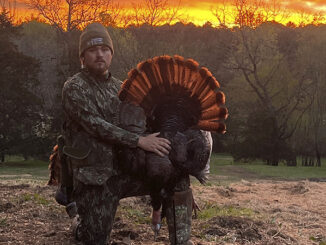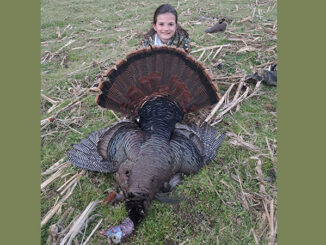
Mountain trails through North Carolina’s public lands can provide access to plenty of ruffed grouse.
Lindy Ammons of Robbinsville is a lifelong grouse hunter who, at 55, still hunts along the steep trails near Fontana Lake Village like a young man, keeping the pace of a power walk.
“I wouldn’t say my job keeps me in shape,” said Ammons, who maintains properties for Brookfield Smoky Mountain Hydropower, which operates power generation facilities at Fontana and other lakes, “but it keeps me busy and moving around a lot. You are going to be moving around a lot if you are going to find a grouse.”
Ammons, whose grouse dog is Clyde, a 4-year-old English setter, remembers times when flushing seven or eight grouse per day was commonplace in Nantahala National Forest near Fontana Lake. He became so addicted to hunting grouse that he headed to Michigan’s Upper Peninsula during its ruffed grouse heyday.
“Back when the ruffed grouse cycle peaked in 1998, we hunted the U.P. and shot dozens during one trip,” he said. “That was a great time for me and my friends, and it was great experience for our bird dogs. Nowadays, around Pisgah and Nantahala (national forests), if you flush one to three grouse, you have had a good day. If you shoot one, you have had an exceptional day. What you are really doing is getting out, hiking for the exercise for yourself and your dog. If you enjoy doing that, you can still shoot some grouse.”
Ammons fits Clyde with a tracking collar and electronic training collar. The GPS collar helps him locate Clyde when he is out of hearing range, and the training collar compels him to return if he ranges too far.
“Grouse hunting is a game of miles,” Ammons said. “The farther you walk, the better the chances are you will find a grouse. That is why I like giving the dog his head. If he starts tracking a grouse, I want him to follow until he finds it and points it. A grouse can cover a lot of ground while it is feeding. But he will usually hold a long time for a point, giving you time to get there to make the flush.”
Some of the trails Ammons hunts begin at the outskirts of Fontana Resort Village. They cross roads and each other, creating an extensive hiking network. It pays to have a trail map to when planning a hunt.
“You might see a trail on a map and it looks like as though it is not very far to the next road or intersection,” he said, “but it may be so steep or crooked that it takes twice as long to walk it as you thought. You don’t want to run out of water or daylight before you make it back to your vehicle.
“Once you become familiar with a certain trail, you may be able to figure out a shortcut where you can slip down the face of a mountain to get to another section of the same trail or to another trail. Otherwise, you have to keep walking the trail you’re on and turn around to go back. I have shot grouse while walking back out on the same trail, but it’s better to make a loop.”
Ammons plans his hunts according to cover, linking good spots like playing a connect-the-dots puzzle. Grouse must have dense, early successional cover for nesting and brood habitat. One of the trails he hunted had a starting point hidden from view of a paved road.
“You have to be careful where you park,” he said. “Other hunters are also around. I parked here once and someone saw my pickup and found the spot. I came later on and there were empty shotgun shells everywhere. It pays to pick up your empty shells to keep other people from figuring out where you are hunting.”
One day a year ago, the first place Ammons hunted was a steep trail winding up and around a mountain. The cover was dense young pines and mature hardwoods. He sent his dog down into the hollows where the trail looped around them.
“You can easily spot the dog if he is on point below you, and can see a grouse if it flushes wild,” he said. “But if one flushes on the high side, it usually goes straight up the ridge and over. You hear it, but don’t get a shot.”
Grouse prefer thick, young timber stands. However, there are very few of them at the higher elevations.
“They don’t do much clear-cutting on the national forests anymore,” he said. “The best hunting is in regenerating clear-cuts that have grown back for 10 or 20 years. If you can swing your gun, waist-high, and it doesn’t hit anything, the cover isn’t thick enough.”
Ammons worked the good cover as he entered it, walking trails in mature timber while allowing the dog to work. Eventually he came to an area where the timber had been harvested in the past few years. Rimmed by a firebreak, the vegetation had grown back thick and low.
He followed the firebreak several hundred yards, keeping tabs on Clyde, who worked about 100 yards ahead. Eventually, deadfalls overhanging the firebreak and the tightness of the cover made continuing impossible. He called Clyde and began walking back to the pickup. At one point, he took a shortcut, working his way down a steep slope to bypass a mile of backtracking.
“It is easier to take a shortcut going downhill than going uphill,” he said. “You need to keep going back to the same place and learn a little more about it each time.”
Ammons loaded Clyde into his kennel and drove to another spot he said had been productive in recent years. One hunt resulted in bagging three grouse.
Saplings grew in the trail bed, and trees obscured a rusty gate. Eventually, he made it through some thick evergreens and into a mature hardwood stand.
Ammons maintained his fast pace while making conversation with his partner. A whirring of wings startled them. They were too distracted by conversation and too slow on the draw. The grouse flew up from the bottom where Clyde was hunting, passed over the trail 20 yards away and landed in the rhododendron on the upper side of the trail. It quickly flushed again and glided down the other side of the ridge, hidden from view.
Chris Kreh, the upland game bird biologist for the N.C. Wildlife Resources Commission, said a lack areas where timber has been harvested impairs grouse numbers on the national forests. However, several Commission game lands have good habitat that makes up for their smaller acreage.
“Pisgah Game Land has some grouse,” he said, “not the national forest, but our game-land tracts near Lake James. Pond Mountain, a recent addition, is a good one. It has a Christmas tree farm operation at the top, and you want to avoid that area if workers are there. The upper gate is closed when the road becomes impassible due to snow, but the open habitat is good grouse brood habitat.”
Elk Knob near Boone is another game land, smaller, consisting of pasture, stream bottoms and mixed-aged and composition timber stands with enough diversity to grow grouse.
“Thurmond Chatham has some grouse habitat,” he said. “Three Top is another good one to try. It is the game lands at the higher elevations where you are going to find the most grouse. You have to get above 2,000 feet if you want to find some good grouse numbers. The higher you go, the more grouse you will find. South Mountains Game Land may look good for grouse, but the elevation is too low.”
DESTINATION INFORMATION
HOW TO GET THERE — Take I-40 west to US 74, the Great Smoky Mountain Expressway, to Bryson City, then NC 28 (Fontana Road) for around 25 miles to the Fontana Dam area.
WHEN TO GO — Grouse season opened Oct. 28 and closes Feb. 29. January and February are great months as long as roads and trails remain open, unblocked by ice and snow.
BEST TECHNIQUES —The old saying, “Any dog is better than no dog” applies to grouse hunting. Late in the season, grouse are in the rhododendron thickets where a dog can find them much easier than a human. Pointing dogs are the classic grouse dogs in the south, while flushing dogs like Springer spaniels and Labrador retrievers are more common in the north. Hunters without dogs can have good luck by walking slowly, stopping near cover and changing directions often. If a grouse senses a hunter has detected him, it may flush, even from dense cover.
EQUIPMENT — Grouse hunters typically use light shotguns because of the amount of walking done. Open chokes like skeet are best when loaded with No. 6 through No. 9 shot. Go with heavier loads later in the season because longer shots are available because leaves are off the hardwood trees.
ACCOMMODATIONS — Fontana Resort Village, 800-849-2258, www.fontanavillage.com.
MAPS — DeLorme North Carolina Atlas and Gazetteer, 800-452-5931, www.delorme.com; National Forest Map Store, www.nationalforest.com; N.C. Wildlife Resources Commission game lands maps, www.ncwildlife.org.








Be the first to comment